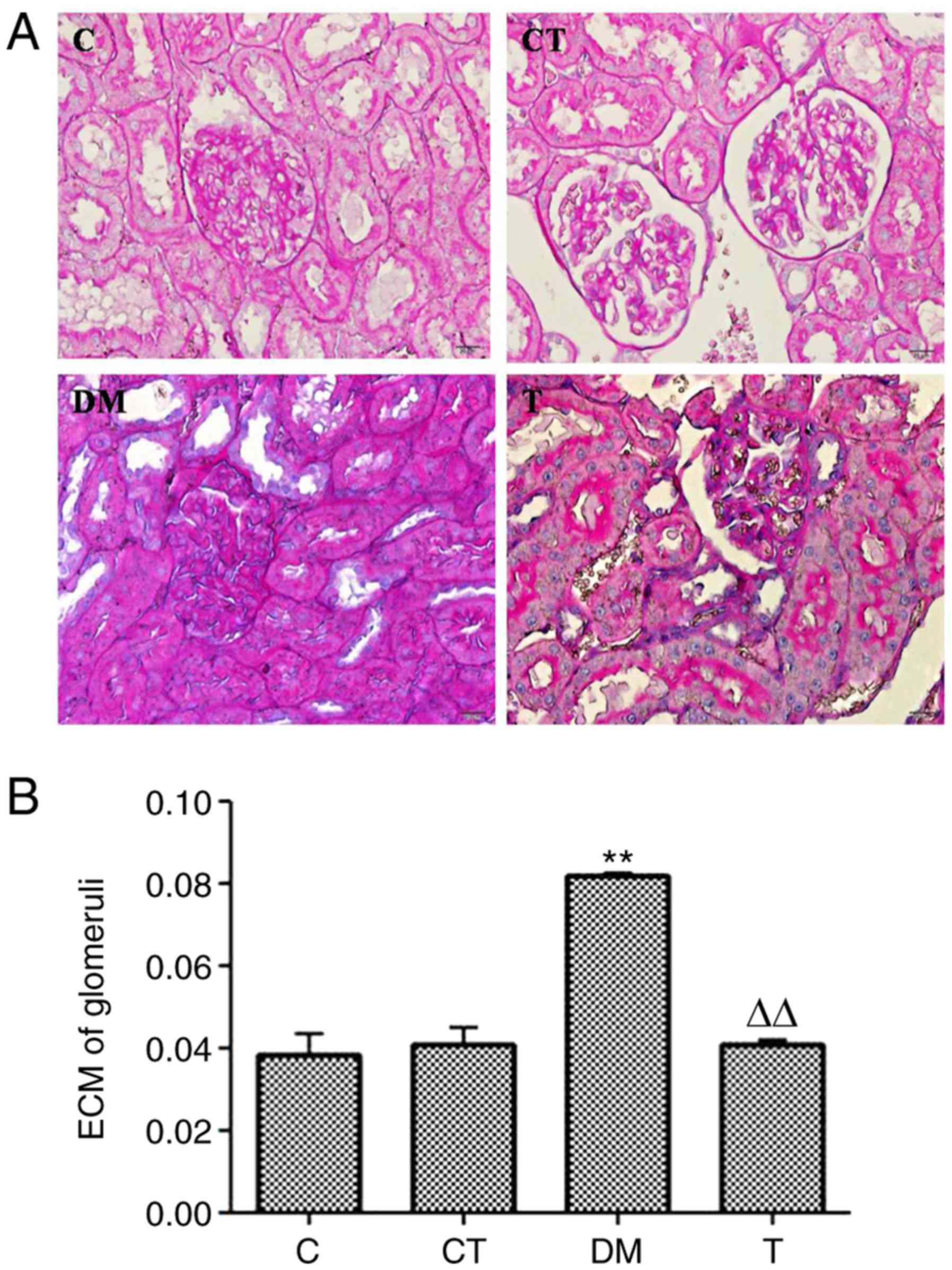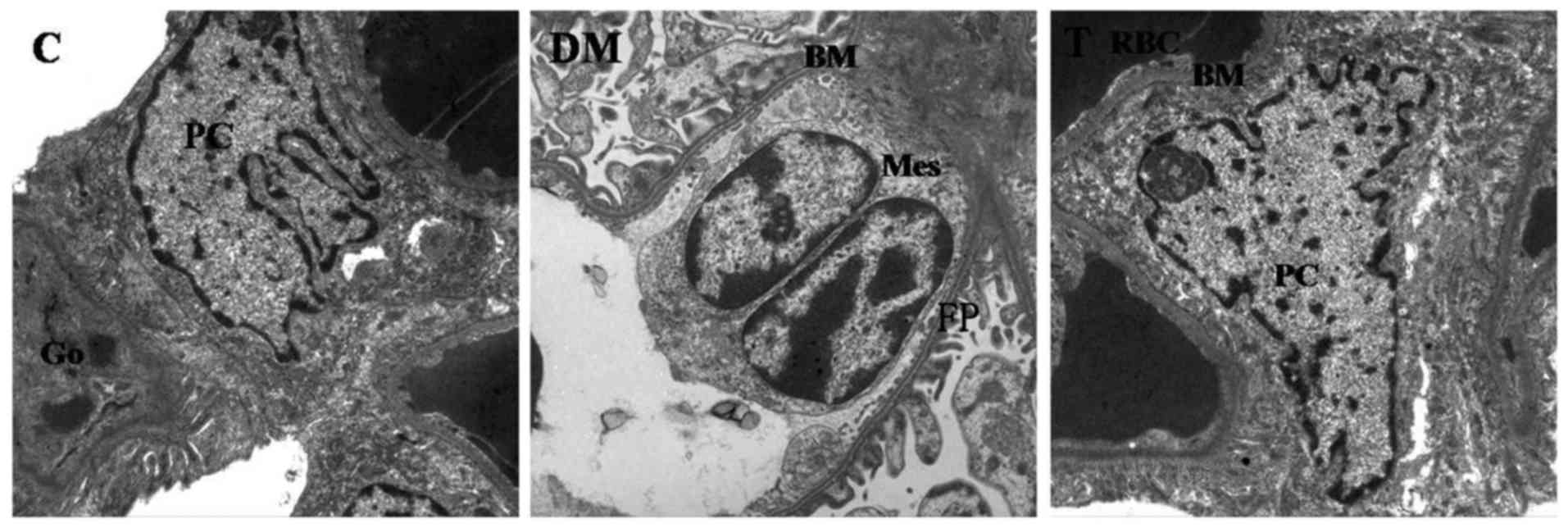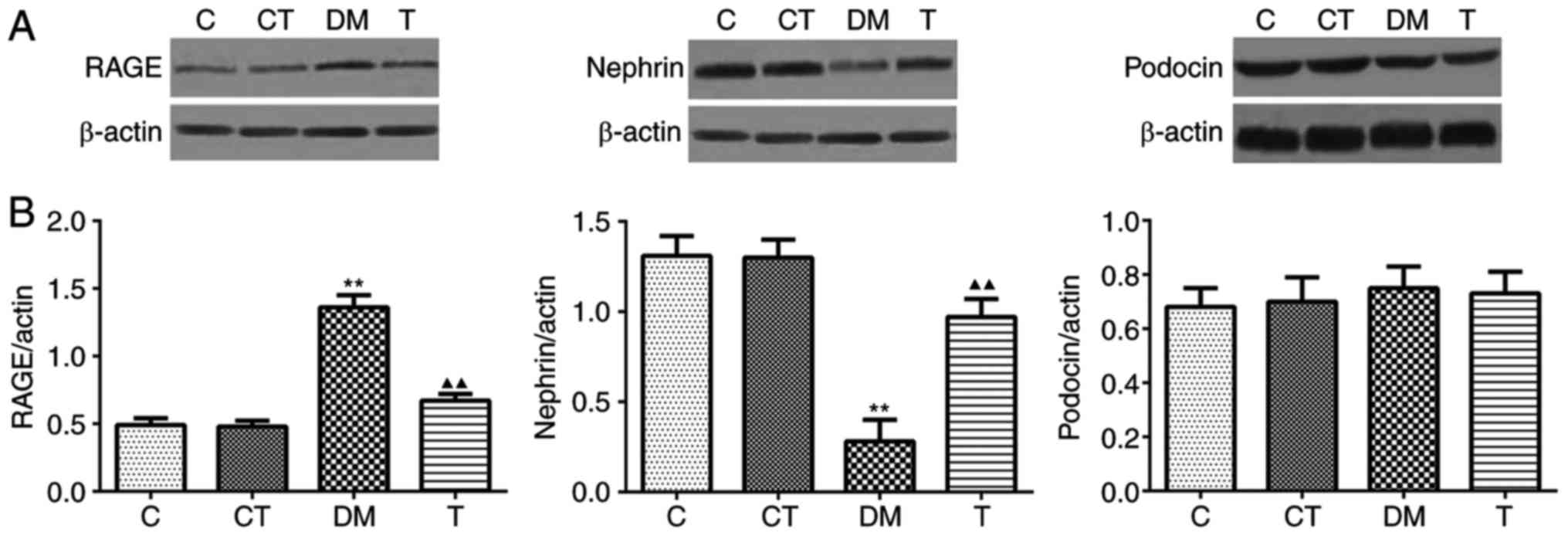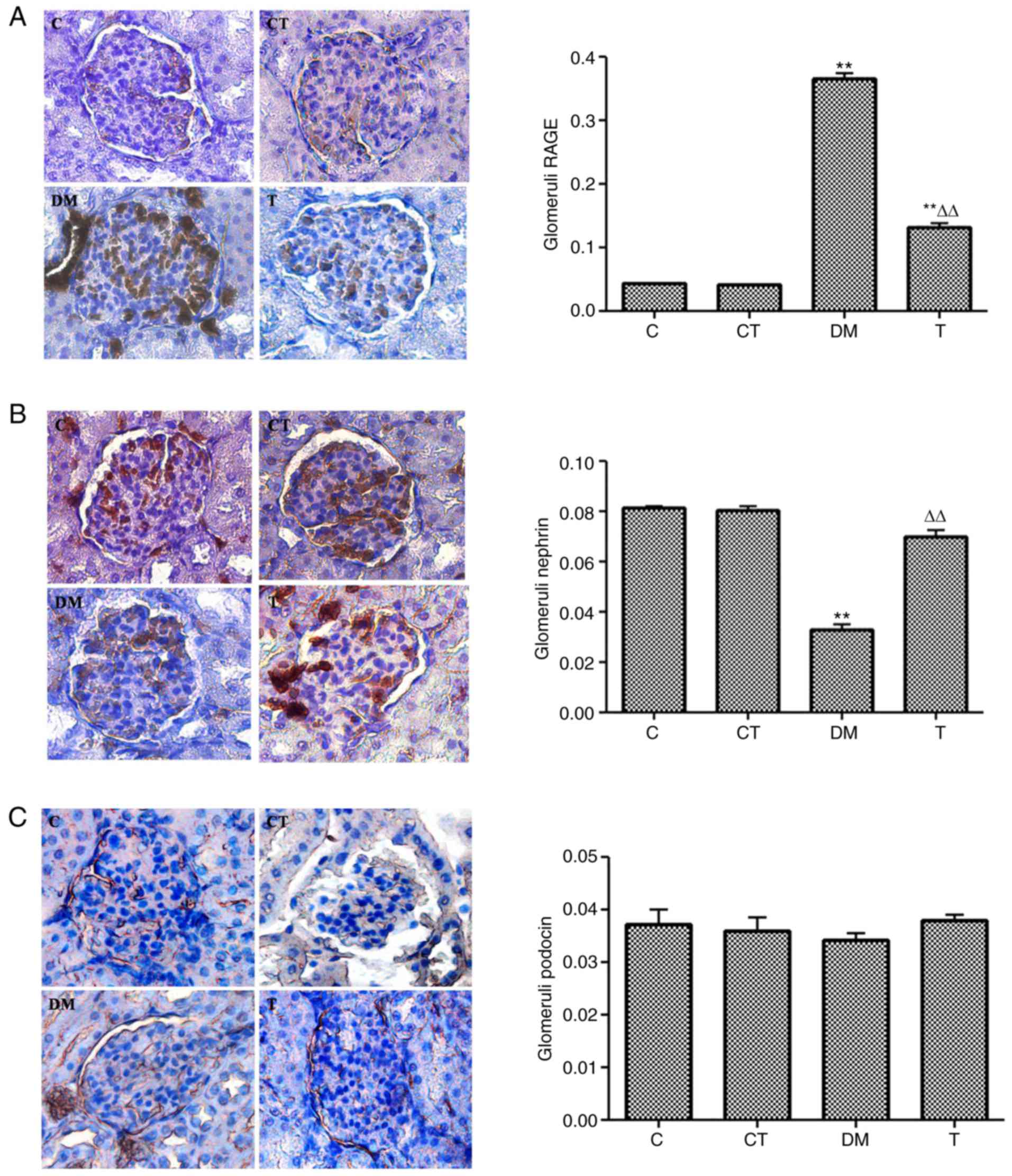|
1
|
Collins AJ, Kasiske B, Herzog C, Chavers
B, Foley R, Gilbertson D, Grimm R, Liu J, Louis T, Manning W, et
al: United States Renal Data System 2005 Annual Data Report
Abstract. Am J Kidney Dis. 57:A82011. View Article : Google Scholar : PubMed/NCBI
|
|
2
|
Zhang Y, Xiao HQ, Wang Y, Yang ZS, Dai LJ
and Xu YC: Differential expression and therapeutic efficacy of
microRNA-346 in diabetic nephropathy mice. Exp Ther Med.
10:106–112. 2015. View Article : Google Scholar : PubMed/NCBI
|
|
3
|
Bhatt K, Lanting LL, Jia Y, Yadav S, Reddy
MA, Magilnick N, Boldin M and Natarajan R: Anti-inflammatory role
of microRNA-146a in the pathogenesis of diabetic nephropathy. J Am
Soc Nephrol. 27:2277–2288. 2016. View Article : Google Scholar : PubMed/NCBI
|
|
4
|
Wolf G and Ziyadeh FN: Cellular and
molecular mechanisms of proteinuria in diabetic nephropathy.
Nephron Physiol. 106:p26–p31. 2007. View Article : Google Scholar : PubMed/NCBI
|
|
5
|
Kim JJ, Li JJ, Jung DS, Kwak SJ, Ryu DR,
Yoo TH, Han SH, Choi HY, Kim HJ, Han DS and Kang SW: Differential
expression of nephrin according to glomerular size in early
diabetic kidney disease. J Am Soc Nephrol. 18:2303–2310. 2007.
View Article : Google Scholar : PubMed/NCBI
|
|
6
|
Welsh GI and Saleem MA: Nephrin-signature
molecule of the glomerular podocyte? J Pathol. 220:328–337.
2009.
|
|
7
|
Daroux M, Prévost G, Maillard-Lefebvre H,
Gaxatte C, D'Agati VD, Schmidt AM and Boulanger E: Advanced
glycation end-products: Implications for diabetic and non-diabetic
nephropathies. Diabetes Metab. 36:1–10. 2010. View Article : Google Scholar : PubMed/NCBI
|
|
8
|
Fukami K, Yamagishi S, Ueda S and Okuda S:
Role of AGEs in diabetic nephropathy. Curr Pharm Des. 14:946–952.
2008. View Article : Google Scholar : PubMed/NCBI
|
|
9
|
Park CH, Noh JS, Fujii H, Roh SS, Song YO,
Choi JS, Chung HY and Yokozawa T: Oligonol, a low-molecular-weight
polyphenol derived from lychee fruit, attenuates
gluco-lipotoxicity-mediated renal disorder in type 2 diabetic db/db
mice. Drug Discov Ther. 9:13–22. 2015. View Article : Google Scholar : PubMed/NCBI
|
|
10
|
Suzuki D, Toyoda M, Yamamoto N, Miyauchi
M, Katoh M, Kimura M, Maruyama M, Honma M, Umezono T and Yagame M:
Relationship between the expression of advanced glycation
end-products (AGE) and the receptor for AGE (RAGE) mRNA in diabetic
nephropathy. Intern Med. 45:435–441. 2006. View Article : Google Scholar : PubMed/NCBI
|
|
11
|
Ramasamy R, Yan SF and Schmidt AM:
Receptor for AGE (RAGE): Signaling mechanisms in the pathogenesis
of diabetes and its complications. Ann N Y Acad Sci. 1243:88–102.
2011. View Article : Google Scholar : PubMed/NCBI
|
|
12
|
Yamagishi S: Role of advanced glycation
end products (AGEs) and receptor for AGEs (RAGE) in vascular damage
in diabetes. Exp Gerontol. 46:217–224. 2011. View Article : Google Scholar : PubMed/NCBI
|
|
13
|
Kaida Y, Fukami K, Matsui T, Higashimoto
Y, Nishino Y, Obara N, Nakayama Y, Ando R, Toyonaga M, Ueda S, et
al: DNA aptamer raised against AGEs blocks the progression of
experimental diabetic nephropathy. Diabetes. 62:3241–3250. 2013.
View Article : Google Scholar : PubMed/NCBI
|
|
14
|
Thallas-Bonke V, Coughlan MT, Tan AL,
Harcourt BE, Morgan PE, Davies MJ, Bach LA, Cooper ME and Forbes
JM: Targeting the AGE-RAGE axis improves renal function in the
context of a healthy diet low in advanced glycation end-product
content. Nephrology (Carlton). 18:47–56. 2013. View Article : Google Scholar : PubMed/NCBI
|
|
15
|
Zhai O, Zhong N, Gao HQ, Li BY and Jiang
B: Grape seed proanthocyanidins extracts promote apolipoprotein A-I
mRNA expression in HepG2 cells under experimental sugar and
high-sugar conditions. Eur Rev Med Pharmacol Sci. 16:299–304.
2012.PubMed/NCBI
|
|
16
|
Okudan N, Barışkaner H, Gökbel H, Sahin
AS, Belviranlı M and Baysal H: The effect of supplementation of
grape seed proanthocyanidin extract on vascular dysfunction in
experimental diabetes. J Med Food. 14:1298–1302. 2011. View Article : Google Scholar : PubMed/NCBI
|
|
17
|
Mansouri E, Panahi M, Ghaffari MA and
Ghorbani A: Effects of grape seed proanthocyanidin extract on
oxidative stress induced by diabetes in rat kidney. Iran Biomed J.
15:100–106. 2011.PubMed/NCBI
|
|
18
|
Liang Y, Qiu J, Gao HQ and Li BY:
Protective effect of grape seed proanthocyanidins extracts on
reperfusion arrhythmia in rabbits. J Nutr Sci Vitaminol (Tokyo).
55:223–230. 2009. View Article : Google Scholar : PubMed/NCBI
|
|
19
|
Makita Z, Vlassara H, Cerami A and Bucala
R: Immunochemical detection of advanced glycosylation end products
in vivo. J Biol Chem. 267:5133–5138. 1992.PubMed/NCBI
|
|
20
|
Lahdenkari AT, Lounatmaa K, Patrakka J,
Holmberg C, Wartiovaara J, Kestilä M, Koskimies O and Jalanko H:
Podocytes are firmly attached to glomerular basement membrane in
kidneys with heavy proteinuria. J Am Soc Nephrol. 15:2611–2618.
2004. View Article : Google Scholar : PubMed/NCBI
|
|
21
|
Koop K, Eikmans M, Baelde HJ, Kawachi H,
De Heer E, Paul LC and Bruijn JA: Expression of podocyte-associated
molecules in acquired human kidney diseases. J Am Soc Nephrol.
14:2063–2071. 2003. View Article : Google Scholar : PubMed/NCBI
|
|
22
|
Osawa G, Kimmelstiel P and Seiling V:
Thickness of glomerular basement membranes. Am J Clin Pathol.
45:7–20. 1966. View Article : Google Scholar : PubMed/NCBI
|
|
23
|
Lam S, Van der Geest RN, Verhagen NA, van
Nieuwenhoven FA, Blom IE, Aten J, Goldschmeding R, Daha MR and van
Kooten C: Connective tissue growth factor and igf-I are produced by
human renal fibroblasts and cooperate in the induction of collagen
production by high glucose. Diabetes. 52:2975–2983. 2003.
View Article : Google Scholar : PubMed/NCBI
|
|
24
|
Yamamoto Y, Kato I, Doi T, Yonekura H,
Ohashi S, Takeuchi M, Watanabe T, Yamagishi S, Sakurai S, Takasawa
S, et al: Development and prevention of advanced diabetic
nephropathy in RAGE-overexpressing mice. J Clin Invest.
108:261–268. 2001. View
Article : Google Scholar : PubMed/NCBI
|
|
25
|
Toyoda M, Suzuki D, Umezono T, Uehara G,
Maruyama M, Honma M, Sakai T and Sakai H: Expression of human
nephrin mRNA in diabetic nephropathy. Nephrol Dial Transplant.
19:380–385. 2004. View Article : Google Scholar : PubMed/NCBI
|
|
26
|
Reddy GR, Kotlyarevska K, Ransom RF and
Menon RK: The podocyte and diabetes mellitus: Is the podocyte the
key to the origins of diabetic nephropathy? Curr Opin Nephrol
Hypertens. 17:32–36. 2008. View Article : Google Scholar : PubMed/NCBI
|
|
27
|
Lee EY, Kim GT, Hyun M, Kim S, Seok S,
Choi R, Lee MY and Chung CH: Peroxisome proliferator-activated
receptor-δ activation ameliorates albuminuria by preventing nephrin
loss and restoring podocyte integrity in type 2 diabetes. Nephrol
Dial Transplant. 27:4069–4079. 2012. View Article : Google Scholar : PubMed/NCBI
|
|
28
|
Kobayashi R, Kamiie J, Yasuno K, Ogihara K
and Shirota K: Expression of nephrin, podocin, α-actinin-4 and
α3-integrin in canine renal glomeruli. J Comp Pathol. 145:220–225.
2011. View Article : Google Scholar : PubMed/NCBI
|
|
29
|
Hussain S, Romio L, Saleem M, Mathieson P,
Serrano M, Moscat J, Diaz-Meco M, Scambler P and Koziell A: Nephrin
deficiency activates NF-kappaB and promotes glomerular injury. J Am
Soc Nephrol. 20:1733–1743. 2009. View Article : Google Scholar : PubMed/NCBI
|
|
30
|
Berg UB, Torbjörnsdotter TB, Jaremko G and
Thalme B: Kidney morphological changes in relation to long-term
renal function and metabolic control in adolescents with IDDM.
Diabetologia. 41:1047–1056. 1998. View Article : Google Scholar : PubMed/NCBI
|
|
31
|
Mifsud SA, Allen TJ, Bertram JF, Hulthen
UL, Kelly DJ, Cooper ME, Wilkinson-Berka JL and Gilbert RE:
Podocyte foot process broadening in experimental diabetic
nephropathy: Amelioration with renin-angiotensin blockade.
Diabetologia. 44:878–882. 2001. View Article : Google Scholar : PubMed/NCBI
|
|
32
|
Schermer B and Benzing T: Lipid-protein
interactions along the slit diaphragm of podocytes. J Am Soc
Nephrol. 20:473–478. 2009. View Article : Google Scholar : PubMed/NCBI
|
|
33
|
Tan AL, Forbes JM and Cooper ME: AGE, RAGE
and ROS in diabetic nephropathy. Semin Nephrol. 27:130–143. 2007.
View Article : Google Scholar : PubMed/NCBI
|
|
34
|
Myint KM, Yamamoto Y, Doi T, Kato I,
Harashima A, Yonekura H, Watanabe T, Shinohara H, Takeuchi M,
Tsuneyama K, et al: RAGE control of diabetic nephropathy in a mouse
model: Effects of RAGE gene disruption and administration of
low-molecular weight heparin. Diabetes. 55:2510–2522. 2006.
View Article : Google Scholar : PubMed/NCBI
|
|
35
|
Doublier S, Salvidio G, Lupia E,
Ruotsalainen V, Verzola D, Deferrari G and Camussi G: Nephrin
expression is reduced in human diabetic nephropathy: Evidence for a
distinct role for glycated albumin and angiotensin II. Diabetes.
52:1023–1030. 2003. View Article : Google Scholar : PubMed/NCBI
|
|
36
|
Miyata T and Izuhara Y: Inhibition of
advanced glycation end products: An implicit goal in clinical
medicine for the treatment of diabetic nephropathy? Ann N Y Acad
Sci. 1126:141–146. 2008. View Article : Google Scholar : PubMed/NCBI
|
|
37
|
Cohen MP, Chen S, Ziyadeh FN, Shea E, Hud
EA, Lautenslager GT and Shearman CW: Evidence linking glycated
albumin to altered glomerular nephrin and VEGF expression,
proteinuria and diabetic nephropathy. Kidney Int. 68:1554–1561.
2005. View Article : Google Scholar : PubMed/NCBI
|



















